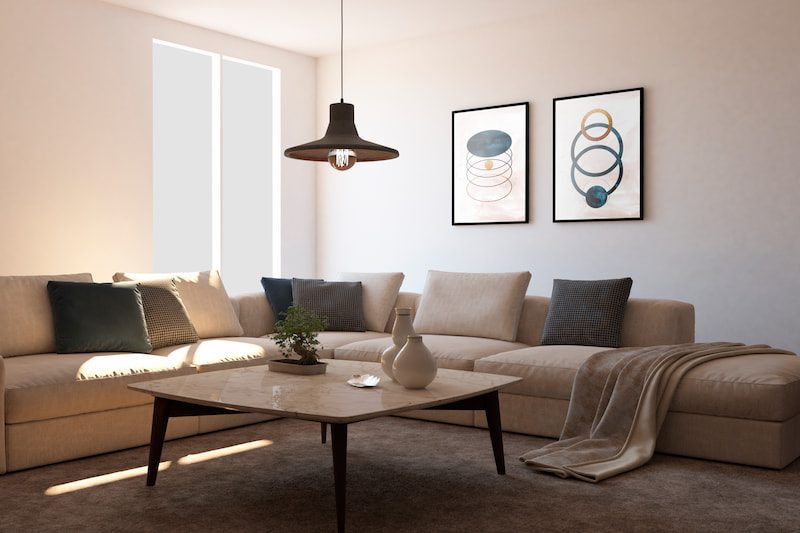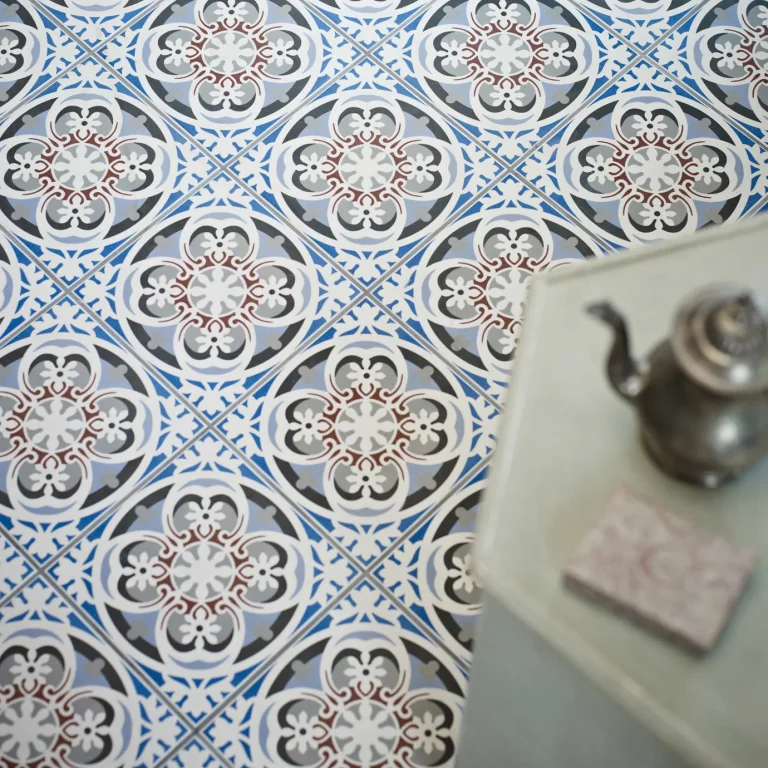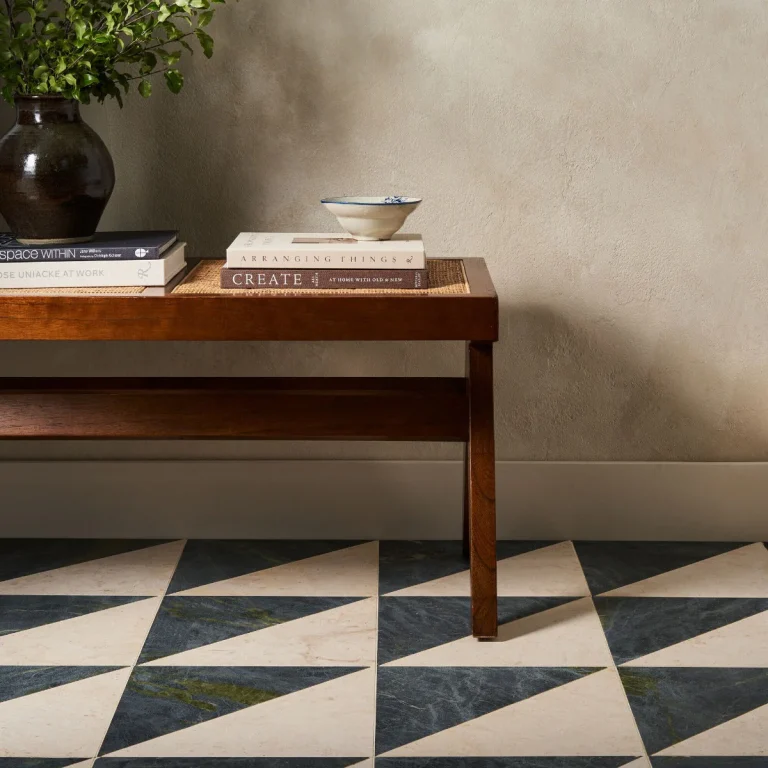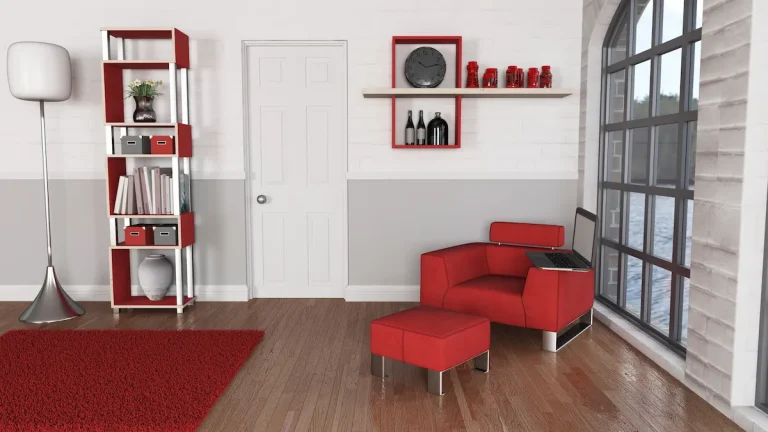Designing a lounge room can be both an enjoyable and complex endeavour, particularly when selecting the appropriate lounge room floor tiles. Floor tiles not only improve the aesthetic appeal of the space but also provide practical advantages such as durability, anti-slip properties, and ease of maintenance.
Are floor tiles good for a lounge room? This article examines the various types of tiles available, assisting you in determining the most suitable option for your living area. Furthermore, we will evaluate the advantages and disadvantages of glossy versus matte finishes and present inspiring tile design ideas, including modern finishes and vintage wood tiles, to enhance your lounge room.
Lounge Room Floor Tiles: An Overview
Selecting the appropriate flooring for a sitting room requires a thorough understanding of the various types of floor tiles available, as this knowledge is essential for achieving the desired aesthetic appeal and functionality.
Floor tiles, such as ceramic tiles, porcelain tiles, and luxurious marble flooring, provide homeowners with durable and stylish options that can significantly enhance the overall appearance of a living room.
Furthermore, materials such as wood flooring, laminate flooring, and decorative tiles can introduce distinctive textures and designs, fostering a warm and inviting atmosphere that reflects personal style while complementing the existing home décor.
The Benefits of Using Floor Tiles for a Lounge Room
The use of floor tiles in a living room presents numerous advantages that enhance both the aesthetic appeal and functionality of the space. Floor tiles are recognised for their durability, making them an ideal choice for high-traffic areas, while also offering a wide range of design styles that can accommodate any aesthetic preference, from contemporary to rustic.
Additionally, the ease of maintenance associated with tiles represents a significant benefit, as they can typically be cleaned with minimal effort compared to other flooring options such as carpet, wood flooring, or laminate. This allows homeowners to maintain a clean and fresh environment with relative ease.
1. Durability
Durability is a prominent characteristic of floor tiles, rendering them an optimal selection for living rooms that experience significant activity and foot traffic. Their ability to withstand the wear and tear associated with daily use enhances both the aesthetic appeal of a space and its cost-effectiveness over time, creating a durable and practical flooring option. By choosing tiles capable of withstanding varying degrees of impact, moisture, and temperature fluctuations, homeowners can ensure that their investment remains beneficial in the long run.
In evaluating the differences among tile options, it is essential to consider the following types of tiles:
- Ceramic Tiles: Known for their versatility and low maintenance requirements, ceramic tiles are fired at high temperatures, which imparts strength and suitability for various indoor environments.
- Porcelain Tiles: These tiles are even more durable than ceramic tiles, possessing a denser structure and moisture resistance, making them ideal for high-traffic areas and environments where spills are frequent.
- Natural Stone Tiles: While these tiles provide a distinctive aesthetic and durability, they may necessitate additional care to prevent staining, depending on the specific type of stone used.
Ultimately, the selection of tile impacts not only the visual appeal of a space but also plays a critical role in maintenance and longevity, ensuring that each renovation project delivers enduring results.
2. Easy Maintenance
Floor tiles are exceptionally easy to maintain, requiring minimal effort to preserve their pristine appearance, in contrast to traditional flooring options such as carpet, wood flooring, or laminate.
This ease of maintenance is one of the primary reasons many homeowners are choosing tiles for their living spaces. Additionally, the ability to select unique tiles such as Crocodile Tiles and Chester Rustic allows for artistic centrepieces within the home. Regular cleaning typically involves a simple mop and bucket along with mild detergent, effectively restoring tiles to their original lustre. In comparison, carpets necessitate frequent vacuuming and specialised cleaning methods to address persistent stains.
Tiles also provide significant advantages in terms of allergen control and maintaining a clean look. Unlike carpets, which can trap dust, pet dander, and other irritants, ceramic and porcelain tiles have a smooth surface that resists such accumulation. This characteristic not only improves indoor air quality but also enhances the overall appeal of selecting tiles over carpets.
- Tiles are stain-resistant and easy to wipe clean.
- They contribute to a healthier living environment.
- Their long-lasting durability reduces the need for frequent replacements.
3. Versatility in Design
The versatility of floor tiles enables homeowners to explore a diverse range of design styles, from modern finishes to vintage wood tiles, thereby accommodating various interior themes and creating a cozy nature in the living space.
By incorporating unique textures and colours, these tiles can significantly enhance the overall aesthetic of a lounge. Homeowners have the option to select from an extensive array of styles, including:
- Contemporary Designs: characterised by clean lines and sleek materials that deliver a polished appearance.
- Classic Patterns: such as herringbone or chevron, which add a timeless elegance to the space.
- Rustic Styles: utilising reclaimed wood or stone finishes that create a warm and inviting atmosphere.
This vast selection of floor tiles not only complements existing décor but also promotes personal expression, allowing individuals to effortlessly craft a space that reflects their distinctive taste and creates a relaxing space.
The Different Types of Floor Tiles for a Lounge Room
There is a diverse range of floor tiles available for living rooms, each presenting distinct characteristics and advantages that cater to varying preferences and requirements.
Options include traditional ceramic tiles, durable porcelain tiles, and luxurious natural stone variations like Carrara Gold and Gaize Dark Oak, all of which offer homeowners the opportunity to customize their spaces according to individual tastes and home decor.
Additionally, vinyl tiles serve as a cost-effective solution, providing modern aesthetics and a practical choice for those seeking a balance of style and functionality in their flooring options.
1. Ceramic Tiles
Ceramic tiles are a widely recognised option for living rooms, valued for their durability, diverse design options, and cost-effectiveness.
These versatile tiles are manufactured from natural clay and subjected to high-temperature firing, resulting in materials that can endure significant wear and tear. Homeowners appreciate the extensive variety of patterns and colours available, enabling them to select options that complement their personal aesthetic and existing décor. Regardless of whether the interior design is contemporary, rustic, or classic, ceramic tiles can seamlessly adapt to each style, offering both practicality and aesthetic appeal.
The advantages of ceramic tiles include:
- Strong resistance to moisture, making them suitable for various environments
- Ease of cleaning and maintenance
- Availability of eco-friendly options that utilise recycled materials
Additionally, with their ability to replicate the appearance of natural stones and wood, ceramic tiles are increasingly preferred for enhancing the elegance of living spaces while maintaining functionality.
2. Porcelain Tiles
Porcelain tiles are recognized for their high density and water resistance, rendering them an excellent option for homes situated in humid environments or areas susceptible to spills.
Along with providing functional benefits, these tiles significantly enhance the overall aesthetic appeal of any space. With a wide array of colours, textures, and finishes available, porcelain tiles can seamlessly complement various design styles, ranging from modern minimalism to rustic charm.
- Strength: Porcelain tiles are less susceptible to chipping and cracking compared to other materials, thereby ensuring longevity.
- Versatility: These tiles can be employed in both indoor and outdoor settings, making them ideal for patios, kitchens, or bathrooms.
- Low Maintenance: They are easy to clean and resistant to stains, requiring minimal upkeep.
Integrating porcelain tiles into a design scheme can elevate its aesthetic value while providing durability, making it a prudent investment for both homeowners and designers looking to enhance contemporary appearances and urban designs.
3. Natural Stone Tiles
Natural stone tiles, including marble flooring and slate tiles, provide a luxurious aesthetic that can significantly enhance the elegance of any lounge, offering a natural look and ambient feel.
The unique veins and patterns present in each piece not only highlight the inherent beauty of nature but also guarantee that every installation is genuinely one of a kind. Natural stone tiles are valued for their durability, making them a sensible investment for homeowners who prioritise both longevity and beauty. Their versatile designs integrate seamlessly with a wide range of décor styles, from traditional to contemporary, thereby enhancing any space effortlessly.
- They withstand the test of time, maintaining their allure even under high footfall.
- The incorporation of natural stone tiles can add an upscale touch, capturing attention and serving as a focal point of interest.
Whether used for flooring, splashbacks, or feature walls, these materials contribute a sense of sophistication and warmth that is difficult to replicate.
4. Vinyl Tiles
Vinyl tiles represent a cost-effective flooring solution that offers significant design flexibility, making them particularly well-suited for a modern lounge area.
Along with their affordability, these tiles provide exceptional practicality and functionality, rendering them an excellent choice for both homeowners and interior designers. The ease of installation is especially advantageous, enabling rapid renovations and decor modifications without the necessity for professional intervention. Vinyl tiles are available in a vast array of styles, colours, and textures, allowing for personalised aesthetics that align with any room’s theme.
Key advantages include:
- Competitive pricing compared to traditional flooring options
- A straightforward installation process, ideal for DIY enthusiasts
- Contemporary designs that can replicate natural materials such as wood or stone
- Durability and low maintenance requirements, making them suitable for high-traffic areas
Given these combined benefits, it is evident why vinyl tiles are gaining popularity in contemporary home design.
Which Type of Tile Is Best for a Living Room Floor?
Selecting the appropriate type of tile for a living room floor necessitates careful consideration of several factors, including foot traffic, the intended use of the room, and budget constraints.
Various types of tiles may be more suitable for specific conditions; for instance, durable porcelain tiles may be optimal for high-traffic areas, whereas more decorative ceramic tiles could be better suited for spaces intended for relaxation and social gatherings.
Gaining a comprehensive understanding of the unique requirements of the space is crucial for making an informed decision that effectively balances aesthetic appeal with practical functionality.
Factors to Consider when Choose Floor Tiles for a Lounge Room
When selecting tiles for a sitting room, it is essential to consider several important factors to ensure the most suitable choice for your home.
Firstly, one significant factor to evaluate is foot traffic. Understanding how frequently the sitting room is used by family members and guests can guide the selection of durable materials that can withstand wear and tear. Furthermore, the primary usage of the room is crucial; determining whether the space is designed primarily for relaxation, entertainment, or dining will influence both the aesthetics and functionality of the chosen tiles.
Additionally, the budget is a critical consideration. Establishing a clear financial allocation for the flooring will help narrow down options and facilitate the identification of choices that meet both quality and style requirements.
- Evaluate foot traffic levels to choose durable tiles.
- Consider the primary activities in the sitting room.
- Set a budget that aligns with your vision and needs.
1. Foot Traffic
The level of foot traffic in the sitting room is a critical factor to consider when selecting flooring tiles, as it significantly impacts durability requirements.
Understanding how various tile types respond to consistent movement is essential for ensuring both lasting appeal and functionality. High-traffic areas, such as sitting rooms, necessitate the use of durable materials capable of withstanding the demands of heavy usage while preserving their aesthetic qualities.
- Ceramic tiles are widely recognised for their resilience and ease of maintenance, making them a preferred option for spaces frequently occupied by family and guests.
- Porcelain tiles provide superior strength and water resistance, rendering them ideal for environments where spills are common.
- Vinyl tiles offer a softer, cushioned feel underfoot, making them suitable for high-traffic zones without compromising durability.
By incorporating these materials, homeowners can make informed decisions, ensuring their flooring endures over time while accommodating vibrant activity.
2. Room Usage
The consideration of room usage is essential, as different activities may necessitate specific flooring characteristics, which will ultimately impact the choice of tiles.
When selecting tiles, the nuances of daily life can significantly influence this decision. For example, if one frequently hosts guests, durability and aesthetics become paramount factors, guiding the selection towards materials that can withstand foot traffic while also presenting an attractive appearance. Conversely, when accommodating active family activities, it becomes crucial to choose tiles that provide slip resistance and ease of maintenance. In contrast, a tranquil space intended for relaxation may benefit from softer textures and muted tones that promote a calming atmosphere.
To illustrate this versatility, consider the following options:
- Guest-Friendly: Porcelain tiles that are both stain-resistant and visually appealing.
- Family-Oriented: Textured tiles that reduce the risk of slips during active play.
- Relaxation Zones: Natural stone or matte finish tiles that contribute to a serene ambiance.
By meticulously considering the function of each space, one can create environments that not only fulfil practical requirements but also reflect individual style.
3. Budget
The budget significantly influences the selection of tiles available for flooring in the lounge.
When considering tile options, it is crucial to acknowledge that various styles and materials come with different price points, catering to both economical and affluent preferences. For instance, cost-effective alternatives such as ceramic and vinyl tiles provide durability and aesthetic appeal without incurring substantial expenses, making them ideal for budget-conscious homeowners.
Conversely, homeowners desiring a more luxurious aesthetic may opt for sophisticated materials such as marble or natural stone, which can enhance the ambience of any space but typically carry a higher price tag.
Cost-effective alternatives include:
- Ceramic Tiles: Affordable and versatile
- Vinyl Tiles: Easy to install and maintain
Recognising these distinctions not only facilitates knowledge-based decision making but also establishes a foundation for a cohesive design plan that aligns with financial capabilities.
Glossy vs. Matte Floor Tiles for a Lounge Room: Which Is Better?
When selecting between glossy and matte floor tiles for a living room, it is crucial to understand the advantages and disadvantages of each finish and their potential impact on the overall design aesthetic of the space.
Glossy tiles can contribute to a more vibrant and reflective environment, thereby enhancing the light within the room. In contrast, matte tiles provide a more understated and natural appearance, fostering a cosy atmosphere.
The choice of finish should be based on the intended aesthetic, maintenance requirements, and the way the finish interacts with other elements of the home décor.
Pros and Cons of Glossy Floor Tiles
Glossy floor tiles provide numerous advantages, including their capacity to reflect light and create a vibrant atmosphere; however, they also present certain drawbacks that homeowners should carefully consider.
These tiles can transform various spaces, from living rooms to bathrooms, imparting an elegant touch that enhances overall interior design. The reflective surface not only brightens rooms but also creates an illusion of greater space, directing the eye along the floor.
It is crucial to acknowledge that while the aesthetic appeal is significant, it is accompanied by practical challenges. Maintaining the glossy finish necessitates regular cleaning to prevent streaks and smudges. Moreover, despite their undeniable beauty, these tiles can become slippery when wet.
- Regular maintenance is essential to preserve their shine.
- Potential slip hazards should be assessed, particularly in areas with high moisture levels.
Homeowners must carefully weigh both the aesthetic benefits and the practical considerations when selecting glossy tiles for their spaces.
Pros and Cons of Matte Floor Tiles
Matte floor tiles offer a natural appearance and a warm ambience; however, they possess both advantages and disadvantages that can affect their appropriateness for living rooms.
The visual appeal of these tiles exudes a sophisticated and understated elegance that can significantly enhance the overall aesthetic of any living room.
Matte tiles and gloss tiles are available in a variety of textures and colours, providing versatile design options that can complement both modern and traditional décor. Additionally, these tiles are typically easier to maintain than their glossy counterparts, as they are more effective at concealing fingerprints and smudges.
However, it is essential to consider potential drawbacks:
- The non-reflective surface of matt tiles may be more prone to staining, particularly in high-traffic areas.
- Cleaning may pose challenges if the surface becomes excessively dirty, necessitating additional effort to restore its original appearance.
In conclusion, the decision to incorporate matte tiles in living rooms should carefully assess both aesthetics and functionality, ensuring a harmonious balance that aligns with individual preferences.
Lounge Room Floor Tile Ideas
What is the best type of tile for a living room floor? When considering floor tiles for a lounge room, it’s essential to think about the space design and how different tiles can create an engaging atmosphere.
In the process of designing a lounge, examining innovative floor tile options can greatly enhance both the aesthetic appeal and functionality of the space. Monochromatic tiles can contribute to a clean and elegant appearance, while patterned tiles can infuse vibrancy and distinct character into the living area. For a more luxury feel, consider using Carrara Gold or Chester Rustic tiles.
Additionally, wood-effect tiles offer the warmth associated with traditional wood flooring without the accompanying maintenance challenges, making them a practical and stylish choice for contemporary interiors. Consider options like Gaize Dark Oak or Vintage Wood Tiles for a rustic finish. These diverse options present numerous creative possibilities for transforming the lounge into a cosy and inviting environment.
1. Monochromatic Tiles
Monochromatic tiles confer a timeless elegance to living rooms, facilitating a sophisticated and cohesive design aesthetic. These tiles can be paired with soft furnishings to create a warm space.
These tiles offer exceptional versatility, seamlessly enhancing a variety of décor themes, whether contemporary, minimalist, or traditional. Their sleek and uniform appearance establishes a seamless backdrop that allows furniture and décor elements to take centre stage.
- Complementary Style: Monochromatic tiles can effectively complement bold colours and patterns, ensuring that the overall ambiance remains chic and inviting.
- Light Reflection: Their smooth surfaces reflect light, contributing to a brighter and more open environment.
- Design Flexibility: Available in a range of textures and finishes, these tiles are suitable for both floors and walls.
This broad appeal makes monochromatic designs a favoured choice among homeowners and designers alike, solidifying their status as a staple in modern interior aesthetics.
2. Patterned Tiles
Patterned tiles can significantly enhance the ambience of a lounge, transforming it into a vibrant space characterised by both personality and style.
These exquisite tiles are available in a wide array of designs, colours, and textures, enabling homeowners to showcase their individuality and personal taste. Whether one opts for geometric patterns that convey a modern aesthetic or intricate floral designs that exude classic elegance, the versatility of patterned tiles is unparalleled. You might also consider incorporating Natural Slate Tiles or Lounge Light Grey tiles for a distinct look.
When selecting tiles, it is important to consider how they harmonise with existing décor:
- Geometric tiles can create a bold statement in contemporary settings.
- Vintage patterns can contribute a charming element to rustic themes.
- Subtle pastels provide a gentle ambience that encourages relaxation.
By carefully selecting the appropriate styles, individuals can not only enhance the visual appeal but also improve the overall atmosphere of the room, creating a warm and inviting space for gatherings and relaxation.
3. Wood-Look Tiles
Wood-effect tiles provide an optimal combination of warmth and style, delivering the aesthetic appeal of natural wood flooring while minimising maintenance requirements.
Beyond their elegant appearance, these tiles demonstrate exceptional resilience and are resistant to scratches, stains, and moisture, making them particularly suitable for high-traffic areas such as living rooms. Homeowners will find it remarkably easy to clean and maintain these tiles, as they require only a mop and a mild detergent to keep their surfaces in pristine condition. For an oak effect, consider using wood-look tiles that replicate the look of natural wood.
The extensive range of colours and textures available offers versatile design options, allowing each living space to reflect individual preferences. Whether one seeks a rustic ambience or a modern aesthetic, wood-effect tiles can seamlessly integrate into any decor scheme, enhancing the overall atmosphere.
4. Marble-Inspired Tiles
Marble-inspired tiles have the potential to enhance the aesthetic appeal of a lounge, providing a luxurious finish that captivates the eye. These tiles are an excellent choice for those undergoing a home renovation seeking a luxury appeal.
These intricately designed tiles replicate the complex veining and natural patterns characteristic of genuine marble, presenting a cost-effective alternative that does not compromise on style. Their sleek surfaces and glossy finishes contribute to the overall ambiance, fostering an inviting yet sophisticated environment suitable for both relaxation and entertainment. These indoor tiles are perfect for those looking to enhance their indoor decor with a touch of elegance.
Key advantages include:
- Versatility: These tiles seamlessly complement a wide range of interior styles, from contemporary to classic.
- Durability: Constructed from high-quality materials, they are designed to withstand daily wear and tear.
- Maintenance: In contrast to natural marble, which necessitates extensive care, marble-inspired tiles simplify the cleaning and maintenance processes, ensuring a pristine living space.
By opting for these remarkable tiles, homeowners can achieve an elegant aesthetic that significantly enhances the value of their property while benefiting from a practical flooring solution.
5. Geometric Tiles
Geometric tiles offer a compelling means to incorporate distinctive designs into a living room, providing a wealth of creative opportunities.
The integration of geometric tiles can significantly enhance the aesthetic appeal of the space, transforming a conventional living room into a visually impressive area that aligns with contemporary design preferences. The versatility of these tiles permits the use of various patterns, such as herringbone flooring, hexagons, and chevrons, which can be applied to floors or presented as eye-catching feature walls.
- Monochrome designs should be considered for a refined appearance. Consider using Chester Rustic tiles for a more textured look.
- Bold colours can invigorate the room, creating a vibrant space.
- Mixing shapes introduces depth and dimension. Pairing different types of tiles can also enhance the overall ambiance and create a more engaging atmosphere.
These design elements can complement other components, such as modern furniture and elegant lighting, fostering a cohesive atmosphere that promotes relaxation and social interaction. The appropriate selection of geometric tiles not only results in a stylish living room but also enhances the overall ambience, establishing the space as a focal point in any modern home.
When selecting lounge room tiles, consider factors like style, texture, durability, and maintenance. Large-format tiles create a spacious feel, while patterned or textured options add character. For a cozy yet elegant touch, neutral tones provide a timeless appeal, while bold designs make a striking statement.
At TEKA Flooring, we offer a wide range of high-quality floor tiles to suit every style and budget. Our experts can help you find the perfect tiles and provide professional installation services for a seamless finish.
Visit TEKA Flooring in Peterborough today to explore the best lounge room tile ideas and bring your vision to life!
Read also:

































